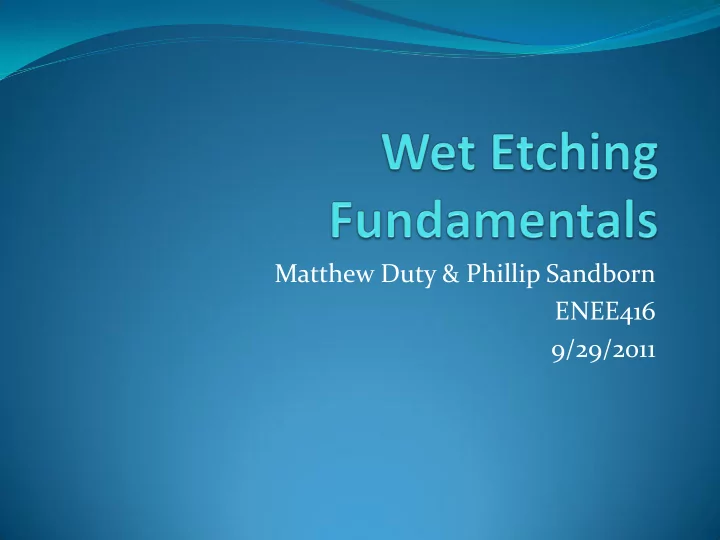

Matthew Duty & Phillip Sandborn ENEE416 9/29/2011
Wet Etch Etch: removal of material from wafer (e.g. removal silicon dioxide) Wet Etch: removal by liquid-phase etchant Dry Etch: removal by plasma-phase etchant
Advantages/Disadvantages + Selectivity + Inexpensive + Speed + Batch process - Isotropic (undercutting) - Temperature sensitivity - Safety - Chemical Waste
Selectivity Ability to etch one material but not another (e.g. silicon dioxide but not silicon) Different etch rates for each material Different etch rates for certain crystal orientations Allows anisotropic etch
Isotropy Mask Material to etch Si-substrate No Undercut Undercut Isotropic : etches equally in all directions Anisotropic : etches at different rates in different directions
Anisotropic Etching Mask <111> 54.74 ° Material to etch <100>
Anisotropic Etching
Etchants – HNA Hydrofluoric acid; Nitric acid; Acetic acid Redox reaction oxidizes Si; Si 2+ reacts to form SiO 2 (reaction with nitric acid) SiO 2 dissolved by HF acid to become soluble in acetic acid Isotropic Etch rate = 1-3um/min Mask: Si 3 N 4 (not SiO 2 !) Low cost Simple Process not easily repeatable
Etchants – KOH Potassium hydroxide Anisotropic (Si plane selectivity: <110>:<100>:<111> = 600:400:1) Etch rate = 2um/min Mask: Si 3 N 4 or SiO 2 (SiO 2 will etch quicker, though) Not CMOS-compatible (Ions contaminate gate oxide) Not allowed in some IC cleanrooms
Etchants – EDP Ethylene Diamine, Pyrochatechol, and water Anisotropic (Si plane selectivity: <100>:<111> = 35:1) Etch rate = 1um/min Mask: SiO 2 Not CMOS-compatible (Ions contaminate gate oxide) Not allowed in some IC cleanrooms Dangerous
Etchants – TMAH Tetramethylammonium hydroxide No alkali ions (CMOS-compatible) Anisotropic (Si plane selectivity: <100>:<111> = 10-35:1) Mask: SiO 2
Stops – Controlling Etch Depth Photolithography Anisotropy Heavily-doped etch stops
References http://www.mrsec.harvard.edu/education/ap298r2004/Erli%20chen%20Fabrication%20 III%20-%20Etching.pdf http://en.wikipedia.org/wiki/Etching_%28microfabrication%29 Jaeger, Richard C. (2002). "Lithography". Introduction to Microelectronic Fabrication . Upper Saddle River: Prentice Hall Schwartz , B., and Robbins, H. “Chemical Etching of Silicon” Journal of the Electrochemical Society , 123 (12), pp. 1903-1909 Collins, Scott D. "Etch Stop Techniques for Micromachining." Journal of the Electrochemical Society 144.6 (1997): 2242-262.
Recommend
More recommend